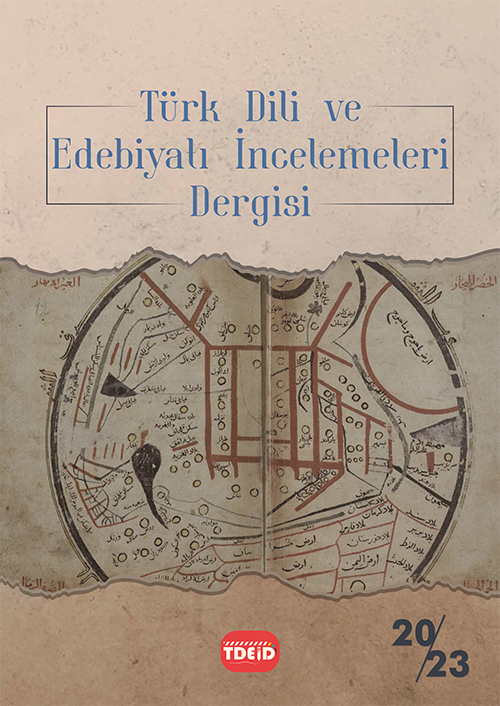Letter Games and “Dâl” as a Letter Transforming into Sound-Word-Symbol in Yahya Bey’s
DOI:
https://doi.org/10.5281/zenodo.10445730Keywords:
Yahyâ Bey, letter games, letter sembolism, letters, letter of the dâlAbstract
Letters are the subject of “science of letters”. In this science, it is believed that letters have a value in terms of form, number and meaning. Poets; They established a relationship between the shape/form of the letters and the characteristics of the lover, the beloved and some beings; They often included letter games based on pointing to a letter or word. One of these poets, Yahyâ Bey (d. 1582), made various word and meaning games based on letters in his Divan; He attributed a symbolic value to some letters. One of these letters is “dâl” (د). “Dâl” is the eighth letter of the Arabic alphabet. It is an element of metaphor used by classical poets, mostly based on its shape. When mentioned in poetry, it is used in a way that evokes the word "dâl", which means "pointing, guiding". “Dâl” has a more original and specific use in Yahyâ Bey's poetry than other letters. First of all, its shape inspired the poet, and the shape sometimes turned into a symbol. Yahyâ Bey used the letter “dâl” as a symbol of the waist/neck bent in half, a show of respect for a bowed body, a symbol of the footprint of the lover's horse, a sign of the lover's footprint (shoe), and a symbol of the crescent. The main difference seen in the use of the letter "dâl" in it is that the picture of a person in thought, the sign of servitude/worship, the state of prostration in worship and absence are symbolically represented with this letter. In this study, first, it is exemplified how Yahya Bey generally included letter games in his Divan, and then, taking into account the visual and auditory value of the letter "dâl", it is explained with examples how the letter turns into a symbol.
References
Aslan, Üzeyir (2008). “Osmanlı Şiirinde Nokta”. Kültür Tarihimizde Gizli Diller ve Şifreler, Haz. Emine Görsoy Naskali-Erdal Şahin. İstanbul: Picus Yayıncılık, s. 294-310.
Çavuşoğlu, Mehmed (1977). Yahyâ Bey Dîvan. İstanbul: İstanbul Üniversitesi Edebiyat Fakültesi Yayınları.
Çavuşoğlu, Mehmed (1983). Yahyâ Bey ve Dîvânından Örnekler. Ankara: Kültür ve Turizm Bakanlığı Yayınları.
Çelebioğlu, Âmil (1998). “Harflere Dair”. Eski Türk Edebiyatı Araştırmaları. İstanbul: MEB Yayınları, s. 599-606.
Demirel, Mustafa (2008). “Eski Türk Edebiyatında Harflerin Dili”. Kültür Tarihimizde Gizli Diller ve Şifreler, Haz. Emine Görsoy Naskali-Erdal Şahin. İstanbul: Picus Yayıncılık, s. 251-264.
Kaplan, Hasan (2018). “Münîrî’nin Şiirlerinde Harf Simgeciliği ve Şairin Elif-nâmesi”. Uluslararası Amasya Şairleri Bilim Şöleni 04-06 Ekim 2018 Amasya, Bildiriler Kitabı, Ed. M. Fatih Köksal-Sibel Murad-Mevlüt İlhan, Ankara: KIBATEK Yayınları, s. 177-208.
Kaplan, Hasan (2022). “Klasik Türk Edebiyatında Elifname Geleneği ve İsmail Hikmetî’nin Elifnameleri”. Akademik Dil ve Edebiyat Dergisi, C. 6, S. 2, s. 437-484.
Kaya, Hasan (2013). “Divan Şiirinde Harf ve Kelime Oyunlarına Dair Bir Tasnif Denemesi”. İ.Ü. Edebiyat Fakültesi Türk Dili ve Edebiyatı Dergisi, C. 48, s. 71-114.
Taş, Hakan (2014). “Me’âlî Dîvânı’nda Harf Oyunları”. Manas Sosyal Araştırmalar Dergisi, C. 3, S. 4, s. 81-95.
Tökel, Dursun Ali (2016). Divan Şiirinde Harf Simgeciliği. 2. bs., İstanbul: Fatih Sultan Mehmet Vakıf Üniversitesi Yayınları.
Zülfe, Ömer (2008). “Emrî Divanında Harf Oyunları”. Kültür Tarihimizde Gizli Diller ve Şifreler, Haz. Emine Görsoy Naskali-Erdal Şahin. İstanbul: Picus Yayıncılık, s. 265-276.
Downloads
Published
How to Cite
Issue
Section
License
Copyright (c) 2023 Türk Dili ve Edebiyatı İncelemeleri Dergisi

This work is licensed under a Creative Commons Attribution 4.0 International License.







